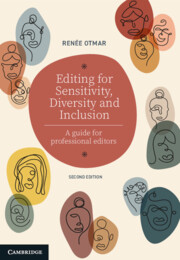Book contents
- Editing for Sensitivity, Diversity and Inclusion
- Acknowledgement of Country
- Editing for Sensitivity, Diversity and Inclusion
- Copyright page
- Dedication
- Contents
- About the author
- Preface
- Acknowledgements
- Part One Foundations
- Part Two Professional practice
- Chapter 5 Identifying the explanatory framework within a text
- Chapter 6 Literary worth versus literary intention
- Chapter 7 Plagiarism
- Chapter 8 Literary appropriation
- Chapter 9 Cultural appropriation
- Chapter 10 Decolonisation
- Chapter 11 Legal reading
- Chapter 12 The main types of critical appraisal
- Chapter 13 Editing for sensitivity, diversity and inclusion
- Chapter 14 Moral and ethical dimensions of editing
- Chapter 15 Developing a workplace policy and style guide
- Chapter 16 Principles for a professional practice
- Chapter 17 Care of the self
- Conclusion
- Part Three Guide
- Index
Chapter 15 - Developing a workplace policy and style guide
from Part Two - Professional practice
Published online by Cambridge University Press: 24 August 2023
- Editing for Sensitivity, Diversity and Inclusion
- Acknowledgement of Country
- Editing for Sensitivity, Diversity and Inclusion
- Copyright page
- Dedication
- Contents
- About the author
- Preface
- Acknowledgements
- Part One Foundations
- Part Two Professional practice
- Chapter 5 Identifying the explanatory framework within a text
- Chapter 6 Literary worth versus literary intention
- Chapter 7 Plagiarism
- Chapter 8 Literary appropriation
- Chapter 9 Cultural appropriation
- Chapter 10 Decolonisation
- Chapter 11 Legal reading
- Chapter 12 The main types of critical appraisal
- Chapter 13 Editing for sensitivity, diversity and inclusion
- Chapter 14 Moral and ethical dimensions of editing
- Chapter 15 Developing a workplace policy and style guide
- Chapter 16 Principles for a professional practice
- Chapter 17 Care of the self
- Conclusion
- Part Three Guide
- Index
Summary
In large and medium-sized organisations, workplace policies are usually developed by executive boards or human resources committees and are implemented by managers; commonly known as a “top-down approach”. As already stated, many of the concepts and practices covered in this guide are new or in development, so editorial staff have an important role to play in influencing policy discussions and development, perhaps even implementation.
Small businesses, community organisations and not-for-profits may not have a written policy but there may be practices of employing or contracting paid and/or volunteer workers that result in a diverse and inclusive workforce, to a greater or lesser extent.
In contrast, to policies, style guides are very much the domain of editorial staff and freelancers or consultants who work on print and digital content. Editors and proofreaders, for example, must keep up to date with word choices, usages and other trends in the literature (books and journals) as well as in society more broadly (news, commentary and the arts). An advantage of this “bottom-up” approach is that editors can provide on-the-ground intelligence in real time, and this enables house styles to reflect readers’ perspectives and practices.
Keywords
- Type
- Chapter
- Information
- Editing for Sensitivity, Diversity and InclusionA Guide for Professional Editors, pp. 145 - 151Publisher: Cambridge University PressPrint publication year: 2023



